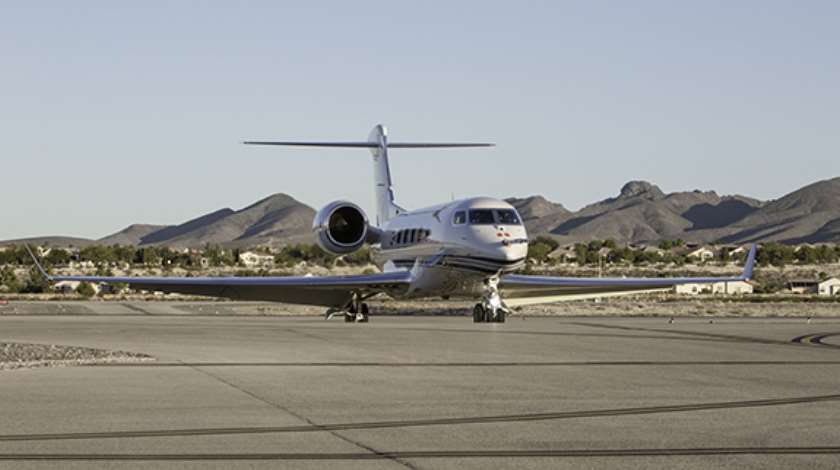Gulfstream Aerospace Corp.’s all-new Gulfstream G500 made its first cross-country trip for the 2015 National Business Aviation Association’s Business Aviation Convention & Exhibition (NBAA2015). The flight test aircraft arrived at Henderson Executive Airport on Nov. 13 to join the G650ER, G550, G450, G280 andG150 in Gulfstream’s static display.
The G500 flew from Savannah/Hilton Head International Airport into 75-knot headwinds and arrived at Henderson Executive 4 hours and 36 minutes later, accomplishing the 1,630-nautical-mile/3,018-kilometer flight at an average speed of Mach 0.85 and altitude of 45,000 feet/13,716 meters. Gulfstream test pilots Scott Martin and Scott Evans were at the controls, with Flight Test engineers Paul Ludlow and Nathaniel Rutland providing on-board support.
“Delivering on our promises is a tradition at Gulfstream, and we look forward to doing the same with our new generation of aircraft, the G500 and G600,” said Dan Nale, senior vice president, Programs, Engineering and Test, Gulfstream. “The robust testing we accomplished on the ground and in the air since announcing the aircraft helped make this achievement possible. We are proud to give customers, the business aviation industry and the public a chance to see the G500 in person at NBAA.”
The G500 flew to Las Vegas with a significant amount of flight testing equipment on board:
- a noseboom, which provides air data, angle-of-attack and angle-of-sideslip information to the pilots and engineers
- Attitude Recovery System (ARS) safety equipment for high-speed flutter testing and low-speed stall testing
- data-monitoring system that provides real-time data for engineers on board and in the telemetry room
- a video recording system that captures touchscreen commands and flight-deck footage as well as external footage of the landing gear, trailing cone and ARS
- flutter vanes on the wing and horizontal tips
The first G500 test aircraft, T1, is focused on flight performance and controls and has achieved a number of flight-test milestones since its first flight on May 18. The aircraft has flown more than 160 hours, completed 44 flights and reached an altitude exceeding 50,000 ft/15,240 m. Its longest flight was 5 hours and 22 minutes. T1 has reached a top speed of Mach 0.995. Flutter and envelope expansion testing are in progress, and initial testing of the aircraft’s handling qualities and the high-speed and recovery stall system have also taken place.
In total, the G500 flight-test program consists of five aircraft, including a fully outfitted production aircraft that allows the company to test all the interior elements and complete integration of the aircraft systems with the passenger experience. T2 and T3 have been delivered to the Flight Test facility and are preparing for first flight.
Gulfstream anticipates certification of the G500 in 2017, with entry into service in 2018. Lab testing for the G600 is ongoing in Gulfstream’s integration test facility, with certification slated for 2018 and entry into service in 2019.
The G500 can fly 5,000 nautical miles/9,260 kilometers at Mach 0.85 or 3,800 nm/7,038 km at Mach 0.90, while the G600 can carry passengers 6,200 nm/11,482 km at Mach 0.85 and 4,800 nm/8,890 km at Mach 0.90. The maximum operating speed for both aircraft is Mach 0.925, the same maximum speed as Gulfstream’s G650 and G650ER.
Source: aviation-news.net
Photo: Gulfstream

